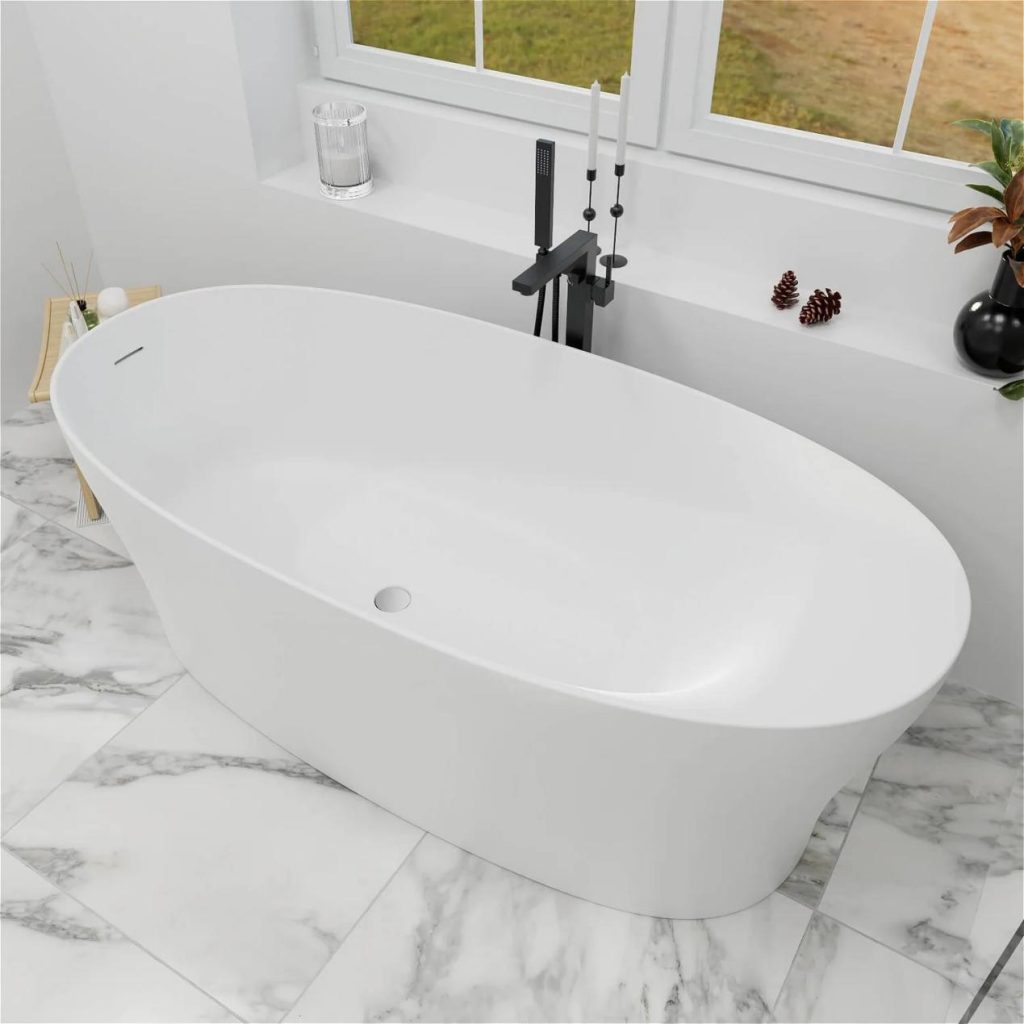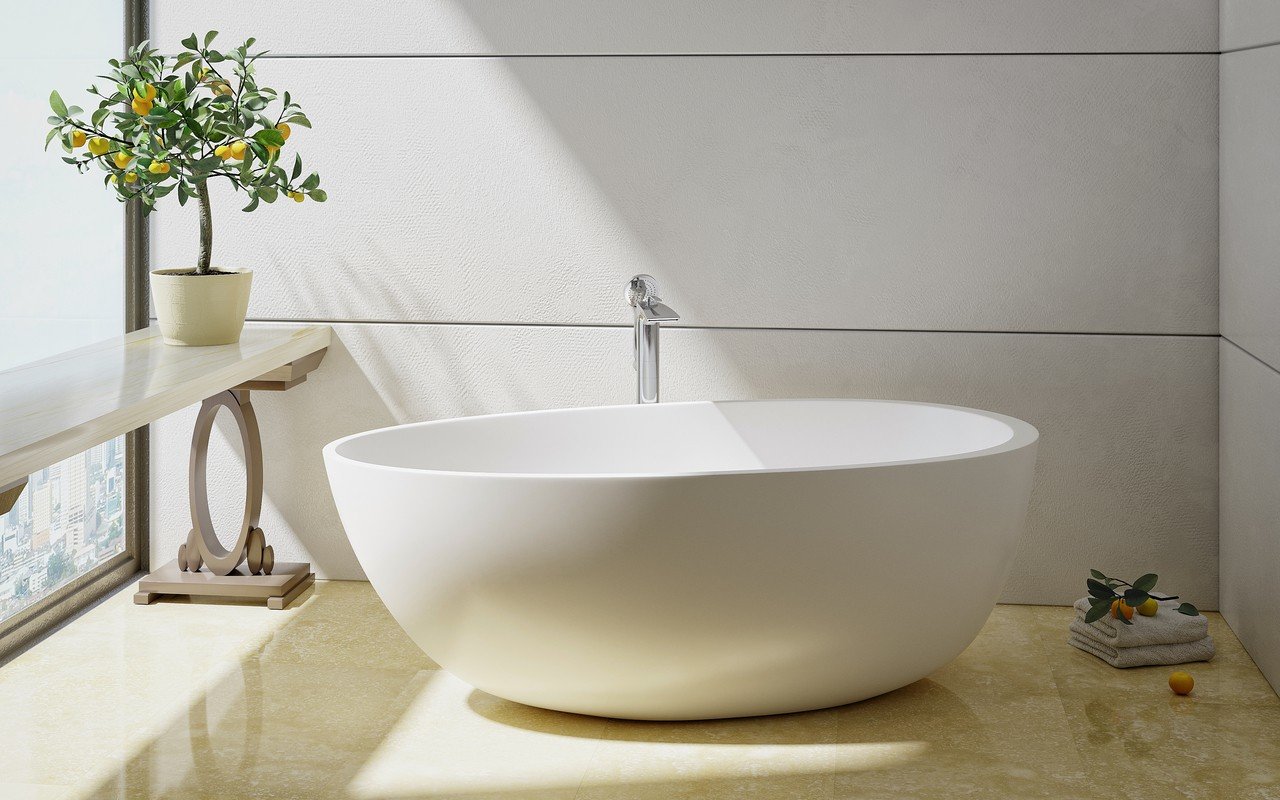When it comes to upgrading your bathroom, the choice of a bathtub is a crucial decision that can significantly impact the overall look, feel, and functionality of the space. Solid surface tubs have emerged as a popular option in recent years, captivating homeowners with their unique blend of style and practicality. However, like any product, they come with their own set of advantages and disadvantages. In this comprehensive blog post, we will delve deep into the world of solid surface tubs, exploring their features, benefits, drawbacks, and everything you need to know before making a purchase.

Understanding Solid Surface Materials
Before we dive into the pros and cons of solid surface tubs, it’s essential to understand what solid surface materials are. Solid surface materials are a type of composite material made from a combination of natural minerals, such as aluminum trihydrate, and synthetic resins. These materials are engineered to create a durable, non – porous surface that mimics the look of natural stone, such as marble or granite, but with added benefits.
Solid surface materials are known for their seamless appearance, as they can be molded into various shapes and sizes without visible seams or joints. This gives them a sleek and sophisticated look that can enhance the aesthetic appeal of any bathroom. Additionally, solid surface materials are available in a wide range of colors, patterns, and textures, allowing homeowners to choose a tub that perfectly matches their personal style and bathroom decor.
Advantages of Solid Surface Tubs
1. Aesthetic Appeal
One of the most significant advantages of solid surface tubs is their exceptional aesthetic appeal. The seamless nature of solid surface materials creates a smooth, continuous surface that exudes elegance and luxury. Unlike traditional bathtubs made from materials like porcelain – on – steel or acrylic, which often have visible seams or joints, solid surface tubs have a uniform look that is both visually appealing and easy on the eyes.
Solid surface tubs can be customized to fit any bathroom design, from modern and minimalist to traditional and ornate. They are available in a variety of shapes, including rectangular, oval, and freestanding, allowing homeowners to choose a tub that complements the layout and style of their bathroom. Additionally, the wide range of colors and patterns available in solid surface materials means that you can find a tub that matches your existing decor or creates a bold statement in your bathroom.
2. Durability and Longevity
Solid surface materials are incredibly durable and resistant to scratches, stains, and chips. The combination of natural minerals and synthetic resins creates a tough, hard – wearing surface that can withstand the rigors of daily use. Unlike acrylic tubs, which can be easily scratched or damaged, solid surface tubs maintain their smooth, glossy finish over time, even with regular exposure to soap, shampoo, and other bathroom products.
In addition to their resistance to physical damage, solid surface tubs are also resistant to mold, mildew, and bacteria. The non – porous nature of the material prevents moisture from seeping into the surface, creating an inhospitable environment for these harmful organisms. This makes solid surface tubs a hygienic choice for bathrooms, especially in households with children or individuals with sensitive skin.
3. Easy Maintenance
Another major advantage of solid surface tubs is their ease of maintenance. Unlike natural stone tubs, which require regular sealing and polishing to maintain their appearance, solid surface tubs are relatively low – maintenance. To clean a solid surface tub, simply wipe it down with a mild soap and water solution and a soft cloth. Avoid using abrasive cleaners or scrubbers, as these can scratch the surface of the tub.
In the event that your solid surface tub does get scratched or damaged, the material can be easily repaired. Minor scratches and blemishes can often be buffed out using a non – abrasive polishing compound, while more significant damage may require professional repair. However, compared to other bathtub materials, the repair process for solid surface tubs is relatively simple and cost – effective.
4. Comfort
Solid surface tubs are designed with comfort in mind. The smooth, non – porous surface of the material feels warm and inviting against the skin, making it a pleasure to soak in. Additionally, solid surface tubs can be molded into ergonomic shapes that provide excellent support for the body, reducing the risk of discomfort or fatigue during long soaks.
Some solid surface tubs also feature built – in headrests, armrests, and footrests, further enhancing the comfort and relaxation experience. These added features make solid surface tubs an ideal choice for individuals who enjoy taking long, luxurious baths as a way to unwind and de – stress.
5. Customization Options
One of the biggest advantages of solid surface tubs is their high level of customization. Because solid surface materials can be molded into any shape or size, homeowners have the freedom to create a tub that is truly unique and tailored to their specific needs and preferences. Whether you want a tub with a built – in shelf for holding bath products, a tub with a sloping backrest for added comfort, or a tub with a custom – designed drain, a solid surface tub can be customized to meet your exact specifications.
In addition to customizing the shape and size of the tub, homeowners can also choose from a wide range of colors, patterns, and textures to create a tub that matches their bathroom decor. This level of customization allows you to create a bathroom that is both functional and stylish, reflecting your personal taste and style.
Disadvantages of Solid Surface Tubs
1. Cost
One of the main drawbacks of solid surface tubs is their cost. Because solid surface materials are a high – end, premium product, solid surface tubs tend to be more expensive than traditional bathtubs made from materials like porcelain – on – steel or acrylic. The cost of a solid surface tub can vary depending on the size, shape, and design of the tub, as well as the quality of the materials used.
In addition to the initial purchase price, the cost of installation for solid surface tubs can also be higher than that of other bathtub materials. Because solid surface tubs are heavy and require specialized installation techniques, it’s important to hire a professional installer with experience working with solid surface materials. This can add to the overall cost of the project, making solid surface tubs a less affordable option for some homeowners.
2. Weight
Solid surface tubs are relatively heavy compared to other bathtub materials, such as acrylic or fiberglass. This is because solid surface materials are made from a combination of natural minerals and synthetic resins, which are denser and heavier than other materials. The weight of a solid surface tub can make it difficult to transport and install, especially if you are doing the installation yourself.
In addition to the installation challenges, the weight of a solid surface tub can also pose a structural risk to your bathroom floor. Before installing a solid surface tub, it’s important to have your bathroom floor inspected by a professional to ensure that it can support the weight of the tub. If your bathroom floor is not strong enough, you may need to reinforce it or choose a lighter – weight bathtub material.
3. Heat Retention
While solid surface tubs are comfortable to soak in, they do not retain heat as well as some other bathtub materials, such as cast iron or copper. This means that the water in a solid surface tub may cool down more quickly than in other types of tubs, requiring you to add more hot water to maintain a comfortable temperature.
To address this issue, some homeowners choose to install a heated floor system in their bathroom or use a bathtub cover to help retain heat. However, these solutions can add to the overall cost of the project and may not be practical for all homeowners.
4. Limited Availability
Because solid surface tubs are a relatively niche product, they may not be as widely available as other bathtub materials. This can make it more difficult to find a solid surface tub that meets your specific needs and preferences, especially if you live in a rural area or a smaller city.
In addition to the limited availability of solid surface tubs, the selection of colors, patterns, and textures may also be more limited compared to other bathtub materials. This can make it challenging to find a tub that perfectly matches your bathroom decor, especially if you have a specific design vision in mind.
Factors to Consider Before Buying a Solid Surface Tub
1. Budget
As mentioned earlier, solid surface tubs tend to be more expensive than other bathtub materials. Before purchasing a solid surface tub, it’s important to set a budget and determine how much you are willing to spend. Consider not only the initial purchase price of the tub but also the cost of installation, any necessary accessories, and ongoing maintenance.
If you are on a tight budget, you may want to consider a smaller, more basic solid surface tub or look for a tub on sale or clearance. You can also save money by doing the installation yourself, although this is not recommended for inexperienced DIYers.
2. Bathroom Size and Layout
The size and layout of your bathroom will play a significant role in determining the type and size of solid surface tub that is right for you. Before purchasing a tub, measure your bathroom carefully and consider the available space, the location of plumbing fixtures, and any other obstacles or limitations.
If you have a small bathroom, you may want to choose a compact, space – saving solid surface tub, such as a corner tub or a freestanding tub with a small footprint. If you have a larger bathroom, you have more flexibility to choose a larger, more luxurious solid surface tub, such as a soaking tub or a whirlpool tub.
3. Personal Style and Preferences
Your personal style and preferences will also play a role in determining the type of solid surface tub that is right for you. Consider the overall style and decor of your bathroom, as well as your own personal taste and style. Do you prefer a modern, minimalist look or a more traditional, ornate style? Do you want a tub that makes a bold statement or a tub that blends in seamlessly with the rest of your bathroom?
Once you have a clear idea of your personal style and preferences, you can start shopping for a solid surface tub that meets your needs. Look for a tub that is available in a color, pattern, and texture that you love and that complements the rest of your bathroom decor.
4. Maintenance Requirements
While solid surface tubs are relatively low – maintenance compared to some other bathtub materials, they still require regular cleaning and maintenance to keep them looking their best. Before purchasing a solid surface tub, consider the maintenance requirements and make sure that you are willing and able to commit to the necessary upkeep.
If you have a busy lifestyle or don’t have a lot of time for cleaning and maintenance, you may want to choose a solid surface tub with a smooth, non – porous surface that is easy to clean and maintain. Avoid choosing a tub with intricate designs or textures that can be difficult to clean and may require more frequent maintenance.
Conclusion:
Solid surface tubs represent a perfect fusion of elegance, durability, and modern convenience. Their seamless design, customizable features, and resistance to wear and bacteria make them an attractive choice for homeowners who value both aesthetics and functionality. While they may come at a higher cost and with certain installation considerations, the long-term benefits often outweigh the drawbacks—especially for those seeking a statement piece that stands the test of time.
If you’re ready to elevate your bathroom with a solid surface tub, Giving Tree Home is a brand you can trust. With a vast collection of styles, colors, and sizes to choose from, Giving Tree Home offers something for every taste and budget. Whether you’re after a sleek freestanding tub or a cozy, space-saving design, their expertly crafted products and attentive customer service make them a top choice for discerning homeowners. Explore their selection today and bring your bathroom dreams to life.
Further Reading: Comparison of Pros and Cons of Solid Surface Bathtubs

